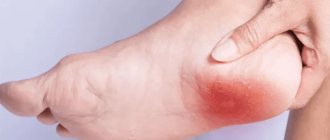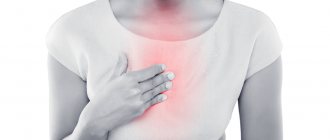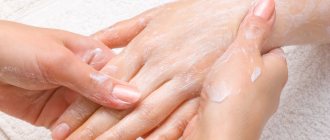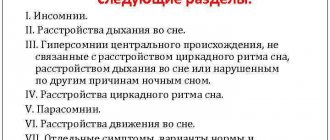Heel spur is a dangerous and unpleasant disease that is common among people of all ages.
Women are 3 times more likely to experience a growth on the heel than men. This “injustice” is associated with wearing shoes with heels, as well as with destabilization of the water-salt balance.
Effective treatment of plantar fasciitis is only possible under the supervision of an orthopedist, however, there are ways to successfully treat heel spurs at home, which also give positive results.
How to treat a heel spur with folk remedies and is it possible to completely get rid of it? You will find detailed answers to these and many other questions in the article.
Is traditional treatment for heel spurs at home effective?
The debate about whether heel spurs can be treated with traditional methods has been going on for a very long time. Proponents of home treatment cite evidence showing the high effectiveness of traditional medicine in getting rid of fasciitis, while their opponents argue that success is impossible without drug therapy.
As always, the truth is somewhere in the middle, so most orthopedic doctors do not reject traditional methods, but strongly recommend combining them with traditional treatment.
What medications are used to treat heel spurs? Orthopedists prescribe the following types of medications to patients:
- painkillers to relieve pain;
- anti-inflammatory ointments based on non-steroidal drugs;
- wound healing agents;
- drugs that normalize metabolism.
In addition, doctors prescribe physical procedures and recommend wearing orthopedic heel supports for heel spurs to reduce pressure and shock-dynamic load on the heels.
In combination with these methods, almost any recipe for treating heel spurs at home will be effective.
About night orthoses and heel spur prevention
Night braces can be used as an additional tool in the treatment of heel spurs. Morning pain occurs as a result of repeated rupture of the fascia that has grown together overnight. At night, a person is in a horizontal position, and his feet are relaxed and extended. In the morning the sole bends. As a result of tension in the fascia, a rupture occurs. If you fix it at night, it will help avoid morning pain, so orthopedists recommend using special splints and night orthoses. An alternative could be long knee socks and additional straps that secure the foot at an angle of 90 degrees.
To ensure that the problem of heel spurs remains in the past and does not affect you in the future, you should pay attention to the following preventive methods:
- treat spinal diseases in a timely manner;
- do not cause flat feet;
- train muscles and ligaments;
- take care of the condition of the joints;
- wear good shoes;
- use hard orthopedic insoles;
- avoid foot injuries and overloads;
- lead an active and healthy lifestyle;
- control weight;
- eat right;
- seek preventive massage services.
Under no circumstances should the disease be neglected, as it gets stronger and becomes more and more difficult to treat. The presence of even minor discomfort and inconvenience when walking is the first sign that you should consult an orthopedic doctor. In advanced cases, surgical procedures may be required. If the cause of the problem is not eliminated, then even after surgery there is a risk that the spur will appear again.
When is it important to treat heel spurs at home?
Fasciitis almost always causes pain and discomfort. The patient literally cannot step on his heel, his gait changes, which leads to deformities of other parts of the foot. As a rule, all folk recipes tell how to cure heel spurs at home and reduce pain.
Also, people with fasciitis often experience inflammation and infection of the soft tissues and tendons in the vicinity of the growth. In this case, disinfection and elimination of the inflammatory process are necessary.
The onset of inflammation is indicated by the following symptoms:
- redness of the heel;
- the foot became hot;
- severe sharp pain;
- the appearance of calluses and corns on the fascia.
If there is severe pain that is not relieved by painkillers, a heel spur block can help. This event has many contraindications and should be carried out after consultation with a doctor.
In most cases, you can reduce the pain and soften the bone-salt thorn with simple remedies and massage for heel spurs at home, without calling a doctor.
Diagnostics
A specialist of any profile will tell you which doctor to contact if you have symptoms of a heel spur. The orthopedist will make an accurate diagnosis based on a history and examination of the patient. The results of an X-ray examination of the foot are of great importance. On an x-ray, as a rule, a spike on the heel tubercle is clearly visible. Among the auxiliary research methods, a general blood test and MRI of the foot can be prescribed.
Differential diagnosis should be carried out for diseases such as:
- bone tuberculosis;
- rheumatoid arthritis;
- gout;
- osteomyelitis.
Comprehensive treatment of heel spurs (plantar fasciitis) at home
The most effective non-surgical method for treating plantar fasciitis today is stretching the heel fascia using special devices and exercises in combination with complete unloading of the foot. This integrated approach gives excellent results and helps eliminate pain and relieve inflammation of the heel tubercle.
When the plantar fascia is stretched, microtraumas heal and the functions of the foot ligaments are restored. Salt deposits no longer collect around the damaged fascia to form a heel spur. The growth stops growing and eventually disappears completely. Regular stretching of the fascia of the foot helps to completely get rid of the spur, eliminates pain, and improves the quality of life.
All products for effective stretching of fascia at home are combined into a unique set for heel spurs ORTGUT FASCIUM.
The kit includes:
- A night splint for heel spurs (orthosis) fixes the leg at an angle of 90 degrees with the fascia stretched to the maximum, eliminating morning “starting” pain.
- The plantar fascia stretching training band improves the flexibility and elasticity of the foot ligaments.
- Arch supports to support the arch of the foot when walking, effectively protecting the heel from stress and shock. Used during the day with shoes or barefoot.
- A massage ball for gymnastics for heel spurs strengthens the muscles of the foot, helps to relax after physical activity, and normalizes blood circulation.
The ORTGUT FASCIUM kit for plantar fasciitis helps eliminate pain, normalizes gait, and restores motor activity without surgery. Regular use of the products from the kit helps to completely get rid of plantar fasciitis and prevent relapse.
You can find out more about the kit and order it with delivery to any region of Russia by following the link.
Causes of heel spurs
A heel spur can be recognized by severe pain in the heel. This is especially noticeable in the morning and at night. The pain may subside during the day. Bone grows on the sole and over time the problem becomes noticeable to the naked eye. The following reasons can provoke the appearance of this defect:
- the presence of excess weight and, as a result, increased load on the foot;
- flat feet, causing excessive tension on the heel bone;
- thinning of the fat pad in old age;
- the presence of connective tissue diseases;
- pathological problems in the spinal column;
- violation of mineral metabolism;
- vascular pathologies;
- consequences of fractures and ligament ruptures;
- frequent and prolonged wearing of low-quality shoes that cause discomfort;
- long periods of standing.
How to treat heel spurs at home with foot baths?
The best option is a bath after therapeutic exercises for heel spurs, containing special exercises.
Foot baths for feet with heel spurs have a positive effect:
- soothe, relieve pain;
- soften growth and rough skin;
- soften calluses and corns;
- disinfect, eliminate unpleasant odors.
The most popular bath recipes are:
Salt + soda.
To prepare, take the hottest water you can tolerate. Pour 3-4 tbsp. spoons of table salt and soda. Lower your feet and hold them until the water cools. It is better to take such a bath in the evening.
After the procedure, carefully dry your feet with a towel and apply cream. The best option is to use a product made specifically for heel spurs.
For example, Pyatkashpor ointments effectively moisturize the skin and help reduce bone spurs.
Iodine + salt.
How to treat heel spurs with iodine and salt? Dissolve 2-3 liters in water at a temperature of +45-50 C. salt and add one ampoule (approximately 50 drops) of iodine. Steam your feet until the water cools completely. After the bath, it is advisable to wear warm socks.
Iodine has a disinfecting effect, and salt softens the growth, eliminating discomfort. To enhance the positive effect, you can take sea salt rather than table salt.
Clay.
Clay baths are indicated for inflammatory conditions. Clay also removes salt deposits well, which cause inflammation of the heel fascia.
It is better to buy clay at the pharmacy, but you can also take regular clay, for example from the garden. The amount of clay is determined “by eye” - the water should become cloudy after adding it.
2.What causes heel spurs?
A heel spur is formed against the background of calcium deposits on the lower part of the heel bone and the formation of inflammatory processes in the surface layer of bone tissue. The development of heel spurs is promoted by increased load on the heel area, various injuries and pathologies associated with damage to the nerves of the lower extremities. Heel spurs are especially common among athletes whose professional activities include exhausting physical exercise: weightlifting and athletics, jumping and running.
Experts identify the following risk factors that contribute to the development of heel spurs:
- Excessive tension in the heel bone, ligaments and nerves in this area, resulting from a specific gait, with flat feet.
- Running and jumping on hard surfaces.
- Obesity and overweight.
- Poorly worn shoes, high heels.
Also, the development of plantar fasciitis occurs against the background of such phenomena as:
- diabetes;
- age-related changes;
- short and frequent bursts of physical activity.
Visit our General Surgery page
How to deal with heel spurs with Dimexide?
Dimexide is a pharmaceutical solution characterized by anti-inflammatory and disinfectant properties. Also, Dimexide for heel spurs helps relieve pain and soften the spine.
The main feature of Dimexide is the ability to penetrate deep into the epidermis, destroying pathogenic microorganisms there. This remedy is indispensable in the presence of inflammation caused by infection.
A heel spur, treated at home with Dimexide, quickly decreases and eventually disappears completely.
The compress is prepared as follows: 1/4 cup of warm water is mixed with 20 ml of Dimexide. Take a multilayer gauze swab and moisten it with the resulting solution. Using a bandage, the tampon is attached to the heel, and a bag or cling film and a woolen sock are put on top. You need to walk with the compress for at least half an hour.
It is better to repeat treatment with Dimexide in the morning and evening for two weeks in a row. After removing the tampon, it is necessary to apply effective ointments for heel spurs with moisturizing and antimicrobial characteristics.
Medical bile: ways to treat heel spurs at home
Natural medical bile is a light brown substance obtained from cows. Bile is used for a variety of medicinal purposes, including heel spurs. The substance has an analgesic effect and also promotes the resorption of bone-saline buildup.
Before removing a heel spur at home using natural bile, the heel must be steamed in a bath with salt or iodine. After this, a gauze swab is applied, generously soaked in bile.
The tampon is left overnight, and the foot is washed in the morning. For best results, it is recommended to wear a sheepskin sock on top or use microwave heated slippers.
Recipes for treating spurs with bile are varied, the most effective among them are:
Bile + red or black pepper + camphor alcohol.
Bile and alcohol are taken in a ratio of 1:2 and infused for a day. Camphor alcohol enhances the effect of medicinal bile. Apply as a compress.
Medical bile + iodine solution + ammonia + honey + glycerin.
All substances are taken in equal proportions. The resulting solution is infused for 2-3 days and applied as a compress. Before use, the mixture must be heated in a water bath.
Bile 200 ml + 50 ml shampoo + 50 ml vodka.
Mix thoroughly and use immediately as a compress.
TOP 10 recipes: how to cure heel spurs at home
We offer 10 best recipes for getting rid of inflamed heel fascia at home:
Recipe 1: Onions and garlic.
Regular fresh garlic against heel spurs is effective due to the presence of powerful immune-stimulating substances in its composition. In combination with onions, which are rich in phagocytes, this gives an excellent anti-inflammatory result.
To prepare the compress, you need 1 medium-sized onion and 3-5 cloves of garlic, which are crushed. The resulting paste must be applied to the spur and kept for at least two hours.
Recipe 2: Rubbing alcohol.
The alcohol must be heated to +40 C and the foot should be lowered until it cools completely. You can use regular vodka. This remedy is especially effective in the evening, when pain from heel spurs prevents you from falling asleep.
Recipe 3: Vinegar and raw chicken egg.
Treatment of heel spurs with vinegar and raw egg is based on the ability of these substances to soften the heel spur. It’s very simple to prepare the ointment: break 1 egg, pour in 1/2 tbsp. 9% vinegar and 100 g butter. Stir and melt the mixture over low heat. When heated, the ointment will thicken. Apply to the affected heel at night.
Note: it is recommended to wear special orthopedic heel pads during the day. They will help relieve pain and discomfort when walking and speed up the treatment process.
Recipe 4: Potatoes.
Raw potatoes, especially young ones with a high starch content, help reduce the thorn. The potatoes are grated and the resulting porridge is applied to the heel. It is recommended to repeat every evening.
Recipe 5: Propolis.
This product is an excellent natural antiseptic and has an analgesic effect. Lotions with propolis help to dissolve the heel spike. Before use, propolis must be softened in a water bath. You need to keep the lotion at night.
Recipe 6: Salt compress.
Regular treatment of heel spurs with salt relieves pain well. To prepare, you need to take sea or table salt, add a spoonful of honey and a couple of drops of iodine. Apply the resulting thick mixture to the sore heel and hold for half an hour.
Another recipe with salt that requires stamina: dissolve 500 g of salt in boiling water and dip your heels in it. This method is not recommended in the presence of acute inflammation and wounds on the feet.
Recipe 7: Pharmacy turpentine.
Used to relieve pain in the absence of inflammation and open injuries of the foot. The sore spot is rubbed with turpentine, and a cotton sock is put on top.
The procedure is best done at night and combined with an orthopedic orthosis or Strasbourg sock.
Recipe 8: Burdock.
Burdock leaves are crushed to a porridge consistency. For severe pain, you can crush and add an aspirin tablet to the mixture. Burdock leaves for heel spurs effectively draw out salts and help get rid of the spur.
Recipe 9: Red pepper.
Take a pinch and put it in your socks. Walk for 6-8 hours. Pepper warms the heel and helps reduce spurs.
Helpful advice: wearing high-quality orthopedic insoles with heel shock absorbers will help to properly unload the feet, eliminate pain and discomfort when walking and speed up the treatment process.
Recipe 10: Aluminum foil.
Quite an extravagant recipe for treating fasciitis. The point of treatment is the effect of metal on the active points of the heel, eliminating pain. To remove a heel spur, you need to take foil, wrap it around your heel and secure it with a bandage.
Indications and progress of the operation
When the first signs of a heel spur appear, do not self-medicate and seek medical help immediately. Surgery is rarely performed, but sometimes it becomes simply necessary. The effectiveness of removing a bone growth through an incision in the skin brings results in 70% of cases, otherwise the pain returns.
Indications
1. No improvement in the patient’s condition within six months.
2. Inability to wait and carry out drug treatment.
3. Decreased performance and restrictions on movement.
How to choose an ointment for heel spurs at home?
When talking about how to get rid of heel spurs using folk remedies, you need to remember about daily foot care. The presence of a spur requires particularly strict adherence to hygiene and antiseptics.
Daily care for feet with spurs includes:
- examining the spur for inflammation, development and infection;
- washing feet;
- treatment with special creams or ointments for the feet.
For regular use, you can use ointments from the Pyatkashpor series. This series contains three types of ointments designed specifically for people with heel spurs. "Pyatkashpor" contains natural bile, which effectively removes growths, softens rough skin and moisturizes.
For inflamed heel spurs, Pyatkaspor Reinforced is recommended; after eliminating the pain and reducing the spur, Pyatkaspor Regular can be used. After completion of treatment, Pyatkashpor Prophylactic is applied as a prophylactic agent.
Symptoms of having a spur
The fact that we are talking about a heel spur is indicated by the presence of the following symptoms:
- heel pain that gets worse after prolonged sitting or lying down. Normal movement causes great discomfort. The man begins to limp. In the evening the pain intensifies;
- gait deformity. Due to painful movements, a person begins to limp or fall to one side;
- discomfort in the heel area, the appearance of red and rough skin, as well as tissue suppuration.
How to remove heel spurs at home without surgery?
Heel spores can be cured without surgery using conservative methods only when a certain condition is created for the heel fascia. The correct condition means the position of the heel in which it is minimally exposed to microtraumas leading to the formation of a heel spur.
In the daytime, taping has this effect; at night, using a Strasbourg sock. Let's look at these tools in more detail.
Taping.
Taping is a method of wrapping the foot to maintain the longitudinal arch. To tape a foot with a heel spur, use a wide adhesive plaster or sports tape. Some pharmacies sell ready-made tapes.
There are several taping techniques, the simplest consists of the following steps:
- Wrap the tape around the foot at its widest point and fix it.
- The next strip is placed on top of the first strip with an overhang of 2 cm. Thus, the metatarsus is fixed.
- Turn the tape around the base of the foot. To do this, secure the tape near the big toe with a bandage and wrap the tape around the heel.
- The tape is passed so as to cross the foot diagonally to the big toe from below. As a result, the tape should end close to where it begins.
- Wrap the tape from the foot to the base of the little toe, fixing the patch. Next, the tape is wrapped around the heel and stretched diagonally back to the little toe.
- The revolutions under points 4...5 are repeated.
A corset is made around the transverse arch: from the base of the toes, the tape is applied around the foot, leaving it open. The ends of the tape are secured with adhesive tape.
Strasbourg sock.
The Strasbourg sock is a special device for fixing the feet in an extended position during sleep. Using the Strasbourg sock is very simple: just put it on and fasten it according to the instructions.
Regular use of the sock while sleeping at night helps relieve pain, prevent the development of spurs and reduce existing growths.
In addition to these orthopedic aids, it is necessary to take care of unloading the heel when walking. Impact load and body weight pressure during movement have a negative impact on the heel spur.
To prevent harmful effects, it is necessary to wear special shoes for heel spurs and orthopedic insoles. The use of a Strutz arch support to support the arch also gives good results.
All these devices are required for the treatment of spurs on the heels; remember that even the most expensive medications and effective folk methods will be powerless if your heels are subject to shock loads during the treatment period.
Prevention
Preventive measures in this case include the following:
- Timely treatment of all orthopedic diseases: diseases of the spinal column, flat feet, etc.
- Increased attention to the condition of the joints, preventing their diseases.
- Choosing the right shoes - without high heels, with a stable last, but not too flat.
- Supplementing shoes with special insoles, which are selected with the participation of an orthopedist.
- Moderate physical activity for the harmonious development of muscles, ligaments and joints.
- Elimination of foot overloads and injuries of various types (avoidance of dangerous situations).
- Regular foot exercises.
- Weight control. Excess weight puts significant stress on the heel area, which can contribute to the development of spurs.
- Proper nutrition with enough nutrients.
It is worth adhering to these recommendations at a young age in order to eliminate the risks of developing the disease in the future or to delay the first signs of a heel spur much further in time.








